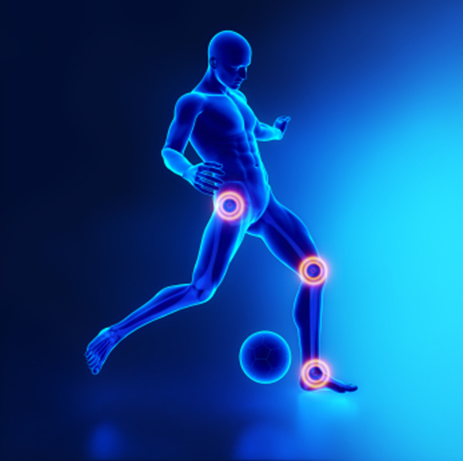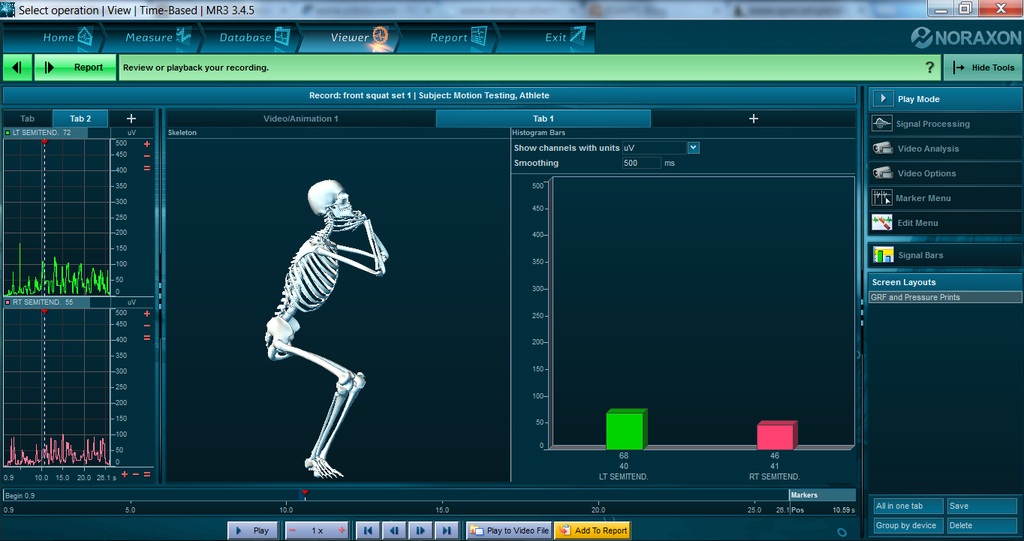
For six weeks now, we shared the needed terminology and concepts to help practitioners develop their own fast and comprehensive approaches to screening, with the goal of helping athletes to reduce injuries. Surface EMG and Motion Capture is growing and evolving with colleges and professional teams each year. What this blog will share is what some of most innovative teams and performance specialists are doing to get an advantage on the field and improve internally with rehabilitation, and more importantly, accelerated communication. Data is flooding everyone involved with the athletic performance and medical space, so teams are looking to find better ways to get information that is relevant and actionable, versus interesting and redundant.
Building a Performance Lab
The data found from a team or clinic's internal use of surface EMG and motion capture every day is shaping the changes in rehabilitation and training. Commonly though, coaches and medical professionals still just read already published research and try to decipher only what is useful and practical, thus claiming they are evidence based. This stunts the growth of new and true evidence based improvements and performance – which are demanded real-time. Better would be for us to create our own, however, historically the problem with research has been that even though much of it is applicable, only the researchers with intricate and complicated lab equipment have the set-up and time to perform the experiments, thus making innovation very slow. With that being said, the ivory tower disconnection between those involved in science, and those working in the trenches, is now a thing of the past. Clinicians and coaches are doing their own real time studies now, and using their own methods to find better ways to help athletes. This is performance. This is staying ahead of the curve. And this is evidence based.
Using Surface EMG to Predict and Prevent Injuries
In the past, rehabilitation and pain management was the primary role of sports medicine doctors, but as strength and conditioning coaches have evolved and become crucial to injury prevention as well, they are now looked at as experts in screening to identify risk and use interventions to decrease risk. Coaches are expected to predict and prevent injuries as much as humanly possible, and whoever is more successful at doing so is far more valuable than those that focus on better rehabilitation programs. Screening is more powerful when the results tell where and why something is not functioning, rather than getting an empty score, void of detail - cause and effect. Interventions are more effective when you know why something in the body is impaired, not a vague summary of a movement pattern. Mentioned earlier, squatting and jumping are excellent movement screens but the true question is now the movement results but the movement causes and contributions. Is a muscle group not firing fast enough? Is the ratio or contributions from different muscle systems off? Is the joint system not supported by enough activity in the area? Countess questions can be answered when comprehensive objective measurements are included. Corrective exercise becomes a laser-guided application versus the shotgun approach which is unavoidable without these tools.
Using Surface EMG to improve Performance
The same data from screening can be used for performance monitoring of athletes for improvement in training. Currently teams are interested in getting the most out of warming up for training and seeing what exercises and training programs change the activity in areas that may be over-recruited or under active. Coaches are looking at EMG metrics from training to see how resistance training and speed development is influencing outcomes.
Example Performance Protocol for NCAA Division I Soccer
A sport specific and skill specific battery of tests was constructed to screen athletes functionally. Similar to an obstacle course, teams save valuable time by including an array of tests strung together to get a lot of key data in a very short period of time. By screening general athletic movements paired with specific soccer actions, the performance staff could see relationships between movement screen results in the clinical assessment, and the findings of their sport specific test series. Relationships like this that are performance based (time or distance) are now bolstered with the information from EMG and kinematics to illustrate how they achieved scores in speed, agility, and power. Five tests are explained in detail and include example risk and performance scoring that leverages inclusion of surface EMG and motion capture.
Agility Station (with or without dribble)
Athletes can see if ball control and general body agility is changed or improved year to year by dribbling and or running through choreographed patterns set by both team and performance coaches.
Performance Example: Improvement in time and muscle coordination.
Risk Example: Lack of deceleration and acceleration, balance, and poor recruitment in muscles that help reduce force in cutting activities.
Short Speed Test
Timing gates set up between 0-15 yards/meters is an excellent way to see if MSS or maximum sprinting speed is improving year to year from strength and speed development.
Performance Example: The change in muscle activity such as the quadriceps, from resistance training programs, and peak activity or silence periods (relaxation).
Risk Example: The inter- and intra-activity of adductors compared to baseline, different team members, and different sports.
Single leg Rotational Hop and Stick
The athlete initiates a single leg vertical jump and turns 90-180 degrees both right and left to the same leg. The athlete must exhibit control on the landing with a minimum hold or “stick time” of the same joint angle, roughly 90 degrees, without having the other foot touch the ground for balance. Coaches can modify this test with displacement horizontally in different patterns as they wish.
Performance Example: Improvements in flight time and contact time to pause, improvements in knee and hip kinematics and symmetry
Risk Example: Lack of normal activity to muscle groups during initiation of jump to poor co-contraction activity and knee collapse during landing.
Bilateral Kicking from Specific Distances
Players perform shots on goal or general kicking patterns in position specific scenarios both legs from different field locations. Shots are scored based on targeted requests and velocities can be seen with laser timing devices or radar gun.
Performance Example: Ball Velocity and Accuracy with both legs
Risk Example: Muscle coordination patterns that change after injury or fatigue that accompany with lack of performance and increase in joint/soft-tissue injury.
Vertical Jump (with or without approach)
A simple vertical jump can be made into a fantastic ACL screening solution, a strength training evaluation method, and performance indicator for player’s ability to get to the ball in air spaces specific to crosses and corner kicks. A gross jump, with counter movement or from static position, is a quick and convenient tool that is timeless and well established.
Performance Example: Wattage or center of mass displacement, muscle activation timing and triggering.
Risk Example: Valgus collapse from lower extremity weakness, due to specific muscle groups.
Registration for the 2014 BSMPG Summer Seminar opens on Jan 1, 2014!





